Editor’s note
See Wild Turkey Habitat Evaluation Worksheet 1 (PDF) and Wild Turkey Habitat Evaluation Worksheet 2 (PDF) for more information.
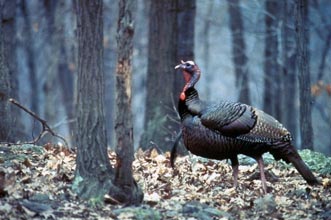
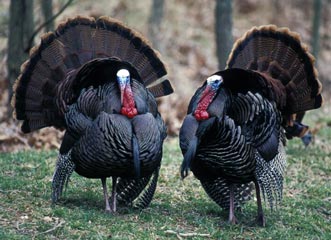
The eastern wild turkey (Meleagris gallopavo silvestris) is one of Missouri’s most valuable and popular wildlife species (Figure 1). Populations exist across the state and provide landowners and hunters alike with enjoyable outdoor experiences that include observing wild turkeys and hunting during the fall and spring seasons. Many Missouri landowners are interested in managing their land to improve habitats for wild turkeys and other wildlife species.
This guide provides an overview of important habitat components that wild turkeys require and two evaluation tools that landowners can use as they make plans to enhance habitats on their property. An understanding of wild turkey biology and their habitat requirements is a first step for successfully implementing management practices on a property. To learn more, refer to MU Extension publication G9526, Wild Turkey Biology and Habitat Management in Missouri and information on wild turkeys from the Missouri Department of Conservation.
Wild turkeys use grasslands, forests, woodlands, croplands and other areas that provide suitable conditions for their survival. Known as opportunistic omnivores, they consume a wide variety of foods. Their diet — which includes grasses and forbs (i.e., broad-leaved flowering plants), hard and soft mast (i.e., nuts, seeds, fruits and berries), and insects — changes seasonally and contributes to their adaptability.
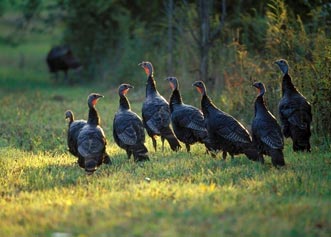
Turkeys have a relatively large home range of several thousand acres and generally do best in landscapes that are about half forested and half open. Open-canopied forests and woodlands provide escape cover, places to roost and loaf, and food in the form of soft and hard mast. Openings provide areas for courtship display, nesting and brood-rearing cover, grasses and forbs for adult food, and insects for poults (Figure 2).
Important habitat components required by eastern wild turkeys
Although wild turkeys have adapted to use a diversity of habitats throughout the year, research has shown that turkeys require specific conditions for producing a successful nest and for broods to survive. These habitat components are briefly described below.
Quality nesting cover
Eastern wild turkeys nest on the ground and lay a clutch of eggs within clumps of grass, leaf litter, downed tree tops, brushy areas or any type of thick understory vegetation. Hens create a shallow depression for a nest bowl. Although a variety of locations can provide nesting habitat, most nest locations are selected based on their ability to provide concealment cover. Woody plants, herbaceous vegetation, brushy areas, vines and fallow crop fields that are at least 18 inches in height can provide this type of concealment cover that may reduce the incidence of nest predation.
Figure 3 provides some examples of this type of habitat. The vegetation that provides this cover type typically occurs two to three years after a disturbance and generally consists of early successional plant communities that are either in the understory or intermixed with forest and woodland habitats.
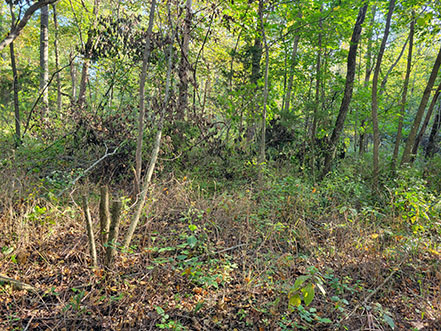
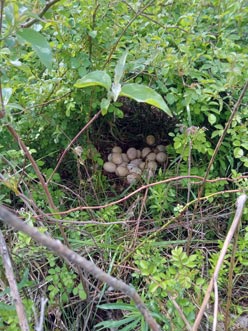
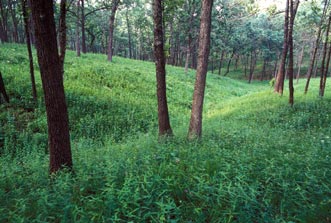
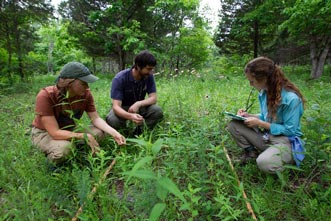
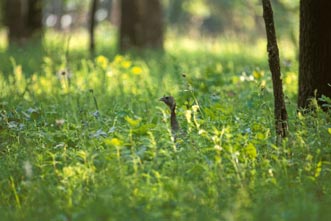
Quality brood-rearing cover
For brood-rearing cover to be most beneficial — especially for poults — it must be located in close proximity to nesting cover. Quality brood habitat for eastern wild turkeys consists of three main elements:
- Vegetation that contains high densities of insects
- Vegetation that is tall enough to provide adequate overhead cover for poults but short enough to allow hens to see above it
- Vegetation that allows thermal cover for poults with enough bare ground so dewy or rain-soaked vegetation can be avoided when it is cold and provides enough shade to be cooler during the heat of the summer
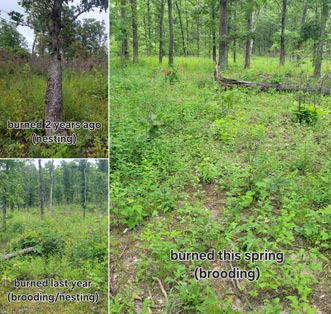
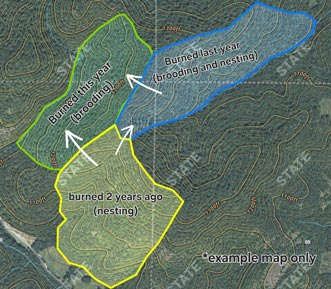
Brood-rearing cover has been found to be one of the most limiting habitat components in the eastern wild turkey’s range. This type of cover typically occurs about one to three years after a disturbance and consists of early successional plant communities that are less than 3 feet in height and dense enough to provide protective cover for poults but not so dense as to impede the their movement in search of food. Please note: The highest quality of brood-rearing cover often occurs during the first year after a disturbance. After that first year, vegetation is often too thick to be considered high-quality brooding cover. By the third year after disturbance, the site is, in most cases, not quality brood-rearing cover. Rotating disturbance on a three-year cycle is, therefore, ideal for providing nesting and brooding cover on a property.
During the first few weeks of life, wild turkey poults are dependent on protein obtained from invertebrates. Many insects, such as grasshoppers and beetles, are associated with new, tender vegetative growth that occurs after a disturbance. Patchy winter burns and other types of disturbances, such as strip disking and timber stand improvements, can produce a mosaic of these insect-production areas, serving as both nesting and brood-rearing habitat. Figure 4 provides examples of the type of cover required for broods.
Quality roosting cover
Adult wild turkeys depend on a certain amount of woodland and forest habitat for roosting cover. In addition, as poults begin to fly, tree roosts with lower limbs, such as trees in the midstory, are important for their survival. Trees are found within most landscapes in Missouri, and thus this habitat component is not usually limiting within their home range.
Take action to improve habitat
Habitat and the diversity of vegetation on a property that wild turkeys require, regardless of its size, can be enhanced by conducting a variety of management practices to help ensure these habitat components are in place (Figure 5). One of the first steps is to evaluate the current habitat conditions to identify any deficiencies, or limiting factors. This evaluation will help to determine the appropriate management practices to implement for wild turkeys.
Importance of evaluating habitat conditions
The habitat components required by eastern wild turkeys are often a byproduct of land use, whether it be forest or agricultural production. However, food and cover for turkeys can be enhanced through various habitat management practices, such as conducting timber stand improvement practices or managing grasslands that promote native grasses and forbs through the appropriate use of disturbance regimens such as prescribed fire or managed grazing. A habitat evaluation helps to determine what may be lacking and helps guide the implementation of management practices that will improve the area and accomplish management objectives.
The habitat evaluation worksheets rate the current condition of the property for its ability to provide suitable habitat for wild turkeys and identify the habitat components that are in short supply — the limiting factors. This information will help determine what management practices to conduct to improve conditions in areas where habitat is lacking or limited quality.
This information can help guide the development of a habitat management plan not only for wild turkeys but also for numerous other wildlife species that benefit from similar management. As previously mentioned, wild turkeys have a home range of several thousand acres. Thus, a property may not be large enough to provide all the important habitat components that wild turkeys require. However, maps can be used to evaluate the larger landscape of which the property is a part. Evaluating habitat and working with neighboring landowners can be an effective approach to improving habitats across larger acreages of land.
Note that it may not be realistic or possible to conduct habitat management for wild turkeys on small acreage properties that are located within extensive areas of extremely poor wild turkey range. The habitat evaluation will likely indicate that the landowner will not receive an adequate return on investment for making habitat improvements due to the poor habitat condition on the surrounding land nor significantly influence wild turkey populations.
Successful evaluation of habitat requires an aerial photo of the property or area being managed and observation of the existing habitat conditions on the area. Aerial photos can be obtained through these websites:
Use your observations and the information obtained from the aerial photos and maps to assess the overall condition of existing habitat. On the habitat evaluation worksheets, rate the habitat components on the property and rank their current condition using the point values provided.
Wild turkey habitat evaluation worksheets
The following two habitat evaluation worksheets were developed to help assess the current conditions of a property to provide quality habitat for wild turkeys. Each of these worksheets can be used to identify important habitat components that wild turkeys require throughout the year and to identify those components that may be limiting. One or both worksheets can be used to evaluate specific tracts of land or the overall landscape in the area at the turkey home range scale of at least 5,000 acres.
Each of these worksheets will serve to identify important habitat components that may be in short supply and need to be addressed. Please note that the attributes of nesting and brood-rearing habitat may significantly overlap. However, the criteria identified in the habitat evaluation worksheets should help to determine the quality of each of those components on the property or within a defined landscape. The optimal time of year for conducting a habitat evaluation is in the spring and summer months, as rating certain habitat criteria — insect abundance, vegetative height, etc. — may be easier to accomplish.
Address the limiting factors
After using the habitat evaluation tools to rate the quality of existing habitat for wild turkeys, action can be taken to conduct management practices that address the limiting factors that have been identified. Here are two examples of how to use the evaluation results to identify potential deficiencies on an area.
If the property consists primarily of woodland or forest, consider these questions:
- Does the area have enough openings that provide the early successional vegetation ideal for wild turkey nesting and brood-rearing?
- Does the forest and woodland contain a diversity of mast-producing oaks and not an overabundance of lower-quality elms, maples and thick, brushy cover?
- Has a disturbance regimen, such as timber stand improvement or prescribed fire, been adopted to maintain the quality of the forest or woodland habitat for wild turkeys?
If the area consists primarily of pastures and cropland, consider these questions:
- Are adequate amounts of vegetative cover located nearby that can provide nesting and brood-rearing habitat and hard mast that provide sources of food?
- Are trees and shrubs needed to provide food and cover?
- Do management practices need to be conducted in grasslands to address a lack of brood-rearing cover?
Considering these types of questions will help to determine the appropriate combination of management practices that will enhance the overall habitat quality for wild turkey on the property and the larger landscape.
Conclusion
Wild turkeys typically have a large home range, using habitats across several thousand acres. Although many Missouri landowners do not own or control large enough properties to effectively manage for a population of wild turkeys, they can manage their smaller acreages to provide quality habitat and take in consideration how their property fits into the larger landscape. Where landownership patterns consist of many small parcels, managing for wild turkeys can be effective when neighbors work together toward similar management goals. Managing a large area provides additional opportunities to implement beneficial management practices on a larger scale. Many of these habitat practices may also benefit other wildlife species of interest, such as white-tailed deer, bobwhite quail, cottontail rabbits and numerous songbird species.
Developing a habitat management plan for your property is an important step in improving the conditions for wild turkey and other wildlife. Before you can develop an effective plan, you need to know and identify the habitat conditions that currently exist. Habitat can be evaluated in several ways. This guide provides two worksheets that landowners can use to assess the quality of habitat for wild turkeys on an area.
Contact a private land conservationist with the Missouri Department of Conservation or a specialist at your local MU Extension center for more specific information or assistance in evaluating habitat and developing a wildlife management plan that features wild turkeys for your property.
Additional resources
- Missouri Department of Conservation, Turkey Habitat Initiative
- Missouri Department of Conservation, Turkey Management
- MU Extension publication G9414, Managing Oaks for Acorn Production to Benefit Wildlife in Missouri
- MU Extension publication G9415, Integrating Woodland and Wildlife Management Practices on Your Property
- MU Extension publication G9526, Wild Turkey Biology and Management in Missouri
- National Wild Turkey Federation
Photographs for Figures 1 through 4 are courtesy of the Missouri Department of Conservation, and Figure 5 is courtesy of Will Rechkemmer with the Wild Turkey Federation.